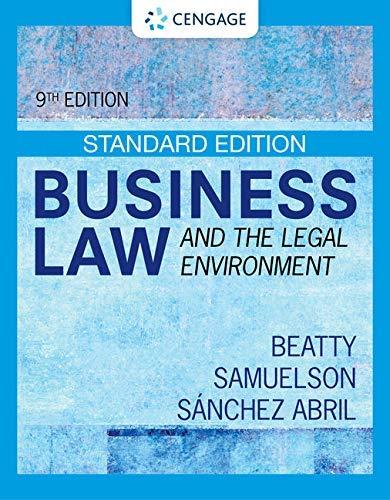Identify The courts reasons for it's finding. Are these reasons sufficient for the court to uphold the lower courts judgment not withstanding the jury is verdict why or why not?Imagine that the judge is operating under a duty base system of ethics. What duty is she advocating in terms of employer employee Relationships? Would this ruling serve well as a universal standard?
BRENNAN v. TOWNSEND & O'LEARY CASE 24-1 Court of Appeals of California, Fourth Appellate District 199 CAL.APP.4 H 1336 (2011) FACTS: Plaintiff Stephanie Crowley Brennan sued her no recovery for harassment that is occasional, isolated, employer for sexual harassment. At trial, plaintiff testified sporadic, or trivial. Courts that have construed federal and that an August 2004 email was the only incident of harass- California employment discrimination laws have held that ment based on her gender directed at her. Although the August an employee seeking to prove sexual harassment based on 2004 email, which referred to plaintiff as a "big-titted, mind- no more than a few isolated incidents of harassing conduct less one" (although it did not mention her by name), was must show that the conduct was severe in the extreme. A rude, insulting, and unprofessional, the record shows it was single harassing incident involving physical violence or the an isolated event as there was no evidence that the sender threat thereof' may qualify as being severe in the extreme. (or any employee of the agency) made any other derogatory Under California's FEHA, as under the federal law's Title remarks about plaintiff, sex based, or otherwise, in any other VII, the existence of a hostile work environment depends context. The evidence showed the email was not intended to be upon the totality of the circumstances. shared publicly. Instead, it was indisputably intended to have In evaluating the totality of the circumstances to deter- been only sent to one person. Plaintiff saw the August 2004 mine the existence of a hostile work environment, the fol- email only after it was inadvertently forwarded it to another lowing factors can be considered: (1) the nature of the employee, who in turn forwarded it to plaintiff. Plaintiff was unwelcome sexual acts or works (generally, physical touch- a vice-president of the agency at the time of the August 2004 ing is more offensive than unwelcome verbal abuse); (2) email, and the author of the email was never her supervisor. the frequency of the offensive encounters; (3) the total A jury found that plaintiff was subjected to severe or pervasive number of days over which all of the offensive conduct harassment based on her gender, in violation of Gov. Code, occurs; and (4) the context in which the sexually harassing $ 12940, of the Fair Employment and Housing Act. The conduct occurred. In determining what constitutes suffi- Superior Court of Orange County, California, granted defen- ciently pervasive harassment, the courts have held that acts dant employer's motion for judgment notwithstanding the ver- of harassment cannot be occasional, isolated, sporadic, or dict, and the employee appealed. trivial, rather the plaintiff must show a concerted pattern of ISSUE: Whether a single email that was inadvertently for- harassment of a repeated, routine or a generalized nature. warded to plaintiff may constitute hostile environment sexual We begin our analysis by observing the trial evidence harassment under the "totality of the circumstances" test? did not support a finding plaintiff was ever subjected to severe sexual harassment. Neither the August 2004 REASONING: Like federal law, California law prohibits email nor any evidence at trial showed plaintiff was ever sexual harassment in the workplace. With respect to sexual assaulted, subjected to "unwelcome physical contact," harassment in the workplace, the prohibited conduct ranges threatened, propositioned, or subjected to explicit lan- from expressly or impliedly conditioning employment ben- guage directed at her or at anyone else in her presence. As efits on submission to, or tolerance of, unwelcome sexual plaintiff acknowledged in her own testimony, the August advances to the creation of a work environment that is 2004 email was the only sexual harassment she claims hostile or abusive to employees because of their sex. Thus, she directly experienced up to that time. Evidence of the similar to the federal law's Title VII, California's FEHA August 2004 email, even when coupled with evidence of recognizes two theories of liability for sexual harassment the few other sporadic claimed incidents of sexual harass- claims, quid pro quo harassment, where a term of employ- ment she witnessed over the years, her conversations with ment is conditioned upon submission to unwelcome sexual Steve O'Leary about her personal life, and her discovery advances and hostile work environment, where the harass- of other incidents of sexual harassment that did not occur ment is sufficiently pervasive so as to alter the conditions of in her presence or immediate work environment, is insuf- employment and create an abusive work environment. ficient as a matter of law to establish the existence of per- In construing California's FEHA, this court has held vasive harassment based on gender. that the hostile work environment form of sexual harass- ment is actionable only when the harassing behavior is per- DECISION AND REMEDY: Judgment for defendant is vasive or severe. This limitation mirrors the federal courts's affirmed. interpretation of Title VII. To prevail on a hostile work SIGNIFICANCE: To be actionable as hostile environment environment claim under California's FEHA, an employee sexual harassment, plaintiff must be able to show a pat- must show that the harassing conduct was severe enough tern of offensive and/or abusive conduct that is severe and or sufficiently pervasive to alter the conditions of employ- pervasive. An isolated incident, unless extremely severe, is ment and create a work environment that qualifies as hos- insufficient to support a claim of hostile environment sex- tile or abusive to employees because of their sex. There is ual harassment. 570







